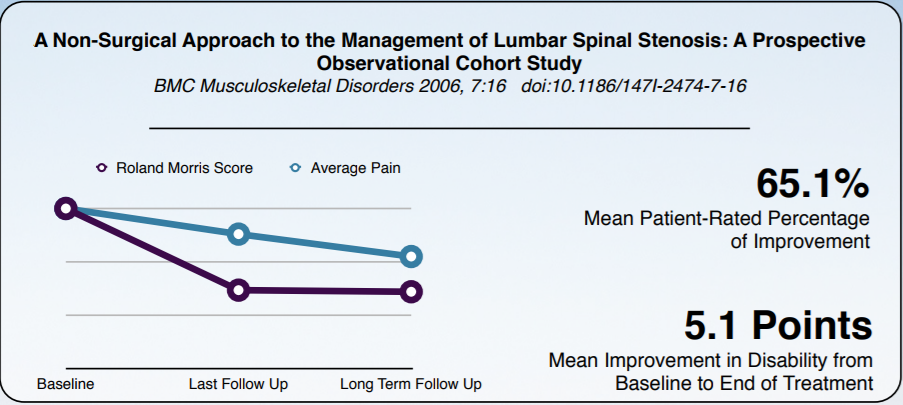Review of “A Non-Surgical Approach to the Management of Lumbar Spinal Stenosis: A Prospective Observational Cohort Study BMC Musculoskeletal Disorders 2006, 7:16 doi:10.1186/147I-2474–7–16”
Lumbar Spinal Stenosis (LSS) occurs in 8–11% of the population. Secondary radiculopathy causing pain down the leg is common. The most common management of this condition is surgical. This study shows that the nonsurgical treatment option of flexion-distraction technique where manual decompression to the afflicted spinal motion segments is combined with mobilization of the segment and decompression of the nerve root has better outcomes.
The pathophysiology of lumbar spinal stenosis includes encroachment on the central canal, lateral recess, or lateral canal caused by vertebral body osteophytes, hypertrophy of the ligamentum flavum or zygapophyseal joint, or a combination of these. “The purpose of this paper is to describe the clinical outcomes of a novel approach to patients with LSS that focuses on distraction manipulation (DM) and neural mobilization (NM).”
The disability of fifty seven patients diagnosed with stenosis was measured with Roland Morris Disability Questionnaire (RM) and pain intensity was measured using the Three Level Numerical Rating Scale (NRS). Patients were also asked to rate their perceived percentage improvement.
Patient-rated percentage improvement in the short term was 65.1%, disability improved 5.1 points, improvement in disability was seen in 66.7% of patients over an average of 16 months. Long term patient-rated percentage improvement was 75.6%. The mean improvement in disability was 5.2 points.
Distraction manipulation (DM) is a manipulative technique developed by Cox where a the patient is prone on a table that allows for distraction of the spine through flexion movement of the lower body. Neural mobilization (NM) mobilizes nerve roots by having the patient lie supine while the doctor or therapist dorsiflexed the ankle and flexed the hip with the knee extended. The leg was raised until the practitioner felt the “barrier” and then the foot is moved alternately into plantar flexion and dorsiflexion repeatedly for several cycles. Additional exercises including “cat and camel” exercise in which the patient is quadruped and alternately flexes and extends the cervical and lumbar spine, and “nerve flossing” exercises.
No major complications to treatment were seen in any patient. Transient increased pain was seen in 12 patients.
“The results of this study suggest that the combination of DM and NM may be useful for patients with LSS.” Clinically meaningful improvement in disability was seen in over two-thirds of the patients.
Originally published at medium.com on August 25, 2017.

